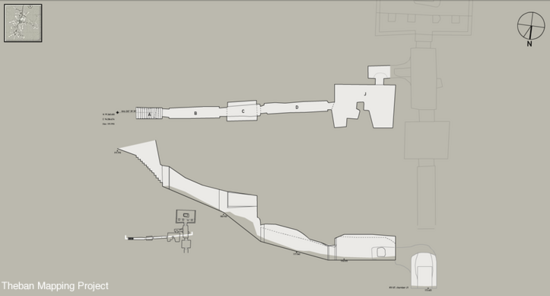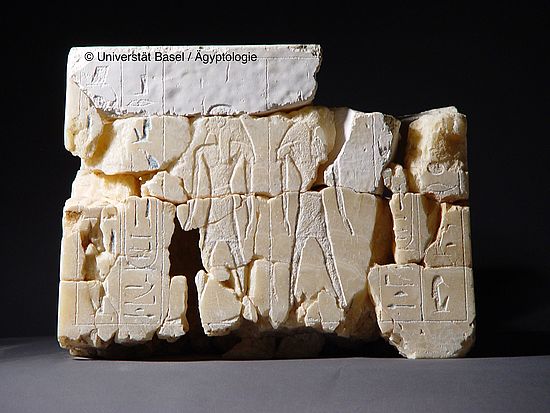Tiaa KV 32: The plant
During the 2000/2001 campaign, not only was the site of the collision between KV 32 and KV 47 (Siptah) investigated, but KV 32 itself was also excavated. KV 32 had already been excavated by Victor Loret, who discovered the tomb in 1898.
The stairway of corridor A is extremely steep and destroyed, so that the access is quite a strenuous climb. Three corridors follow, B to D, of which C is also quite steep, and then the sarcophagus room J. It has one pillar. From the sarcophagus room J there is a side room Ja on the left. From this room the connection to the tomb of Siptah (KV 47) leads off to the right (Fig. 2).
The grave owner and her grave goods
During the 2001/2002 campaign, finds have come to light, some of which name the King Mother Tiaa:
- Fragments from the canopic box of Tiaa.
- Two canopic lids
- Uschebti of the Tiaa
- Miniature coffin of Tiaa
- Tit amulet of the Tiaa
- Udjat amulet
- Djed amulet
- Duck vessels
- Vessel made of glass paste
- Ceramic
- Sham vessel of Sennefer and Senetnai
As an example here in Fig. 3 the figure of the dead (Uschebti) with inscription containing the name Tiaa in a cartouche (name ring).
Tiaa is known as wife of Amenophis II (1413-1388 / 1426-1400 B.C.) and mother of Thutmosis IV. (1388-1379 / 1400-1390 B.C.). Excavations at the beginning of the 20th century in the mentioned tomb of Siptah (KV 47), which also revealed fragments with this name, were - wrongly, as has been shown now - attributed to the mother of Siptah. The reason for the finding of these fragments is that they were washed from KV 32 by rainwater into the tomb of Siptah.
A 111.5 cm high statue of king Thutmosis IV and his mother Tiaa made of black granite, which was originally placed in the temple of Amun at Karnak, is today in the Egyptian Museum in Cairo (Fig. 4).
Among the significant finds of our excavation are fragments of the canopic jar of Queen Tiaa (Fig. 5). Canopic jars are jars in which the viscera removed from the corpse during mummification were buried separately. Tiaa's canopic jar was made of calcite-alabaster. The decoration in sunken relief was painted with blue paint.
From innumerable fragments, Tiaa's canopic box could be assembled using casts of the fragments that are in the Metropolitan Museum of Art in New York (Fig. 6). We thank Catharine Roehrig of the Metropolitan Museum of Art for her cooperation. Essentially all that is missing from the canopic box are pieces from the top and from one of the four walls.
The examination of the undecorated tomb KV 32 has led to the significant conclusion that it belonged to Queen Tiaa of the 18th Dynasty. It is thus the only ascribable tomb of a royal wife in the Valley of the Kings to date. It was not until the Ramesside period (19th and 20th dynasties) that the royal wives received decorated tombs. However, these were not built in the Valley of the Kings, but in a wadi south of it, the so-called Valley of the Queens.
Tiaa survived her husband and died during the reign of her son, Thutmosis IV. Tiaa's mummy has not been identified until now. Possibly it was reburied in the 21st Dynasty together with that of Thutmosis IV in the cachette of KV 35 (Amenophis II). There a female mummy was found (described by Elliot Smith, Catalogie Général, No. 61070, as "the Elder Lady") which has remained unidentified so far (Fig. 7). With modern methods of investigation a genetic connection between the certainly identified mummy of Thutmosis IV and the "Elder Lady" could be verified or falsified.
Publication
Hanna Jenni, Andreas Dorn, Elina Paulin-Grothe. With a contribution by David Aston, The Tomb of Queen Tiaa in the Valley of the Kings (KV 32) (Swiss Egyptological Series SES, vol. 1), Basel/Frankfurt: Librum 2021. DOI 10.19218/3906897479.
Quick Links







